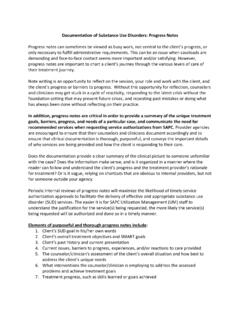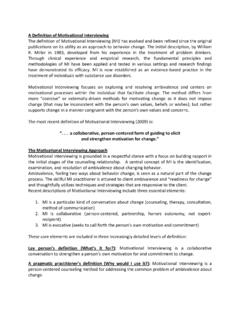Transcription of Motivational Interviewing: A Primer for Child Welfare ...
1 Motivational interviewing is a method professionals can utilize to support families who may be ambivalent or hesitant about support from the Child Welfare system. It was designed to help engage individuals and assist them in exploring and resolving their ambivalence about Given that families often become involved in the Child Welfare system involuntarily and that engagement may be a challenge for caseworkers, Motivational interviewing is a method caseworkers may want to consider in their practice (Mirick, 2013). This factsheet provides Child Welfare professionals with an overview of Motivational interviewing , describes circumstances when it could be applied, and highlights the basics of the method. It also provides links to additional resources. 1 Ambivalence is a common term in the Motivational interviewing literature.
2 It refers to the client s state of both wanting and not wanting to change or, in other words, having simultaneous conflicting motivations. For example, a client may see the negative consequences of her substance use ( , impairing her ability to parent) but at the same time continue using interviewing : A Primer for Child Welfare ProfessionalsWHAT S INSIDEO verviewWhen to use Motivational interviewingBasics of Motivational interviewingWorking toward changeTrainingConclusionReferencesChildr en s Bureau/ACYF/ | Email: | 2017 OverviewMotivational interviewing was developed by W. R. Miller and S. Rollnick. It was first introduced in the 1980s as a method to engage and support adults coping with substance use issues and has since been adapted to meet the needs of other helping fields, including Child Welfare , criminal justice, and health.
3 Miller and Rollnick (2013, p. 29) define Motivational interviewing as follows: Motivational interviewing is a collaborative, goal-oriented style of communication with particular attention to the language of change. It is designed to strengthen personal motivation for and commitment to a specific goal by eliciting and exploring the person s own reasons for change within an atmosphere of acceptance and interviewing was intended for a counseling relationship that could extend several weeks, but it has also been shown to be effective during shorter interventions for substance use, smoking cessation, and peer violence (Higgins, 2015). According to the California Evidence-Based Clearinghouse for Child Welfare (CEBC), Motivational interviewing can be used with caregivers of children, as well as with adolescents (CEBC, ).
4 Additionally, CEBC awarded the method its highest rating ( well-supported by research evidence ). The method has been shown to help engage clients and enhance their motivation to use and complete services including those related to Child Welfare that can support them in making positive life changes (Sterrett, Jones, Zalot, & Shook, 2010; Damashek, Doughty, Ware, & Silovsky, 2011). Using Motivational interviewing also may help caseworkers assess families readiness to change and assist families in better understanding the steps necessary for changes to of Motivational interviewing approach the method with a perspective that includes partnership with the client, acceptance of the client, compassion, and an evocation ( , helping bring forth what is needed for change from the client) (Miller & Rollnick, 2013).
5 These four components are often called the spirit of Motivational interviewing . The Motivational interviewing process includes four overlapping processes engaging, focusing, evoking, and planning that are discussed in greater detail in the Basics of Motivational interviewing to Use Motivational InterviewingThe use of Motivational interviewing may be most applicable when the following circumstances are present (Silovsky, Leffingwell, & Hecht, 2009): The client has a specific target behavior that is leading to negative outcomes. The client is ambivalent about change. Choices that could benefit the client and family are that many parents involved with Child Welfare may have substance use disorders and that children with parents who use substances are more likely to be maltreated, Motivational interviewing holds promise for use with Child Welfare clients ( Child Welfare Information Gateway, 2014).
6 Much like clients in the substance use field, Child Welfare clients may be ambivalent to change, which makes them good candidates for the use of Motivational interviewing . Child Welfare practice also tends to embrace some of the same tenets present in Motivational interviewing , such as engaging clients in decisions and focusing on their strengths. Additionally, Motivational interviewing incorporates self-determination, which is one of the tenets of trauma-informed care. Research has shown that Motivational interviewing is also effective when paired with other treatment strategies, such as cognitive behavioral therapy ( substance Abuse and Mental Health Services Administration, 2017). Motivational interviewing may also be beneficial when supporting youth involved with Child Welfare who are exhibiting negative behaviors.
7 Adolescents often feel they are being judged or told what to do by providers, which is not effective. Instead, using a nonconfrontational and nonjudgmental approach such as Motivational interviewing can help them explore ways to change their behaviors (Hohman, Barnett, & Shillington, 2012). interviewing : A Primer for Child Welfare Professionals2 This material may be freely reproduced and distributed. However, when doing so, please credit Child Welfare Information Gateway. This publication is available online at Welfare professionals should be aware of power differentials and families values when using Motivational interviewing . The power differential between a caseworker and parent or youth could create additional resistance or negative reactions from the parent (Mirick, 2013).
8 Parents may feel forced to comply with a suggested or mandated activity due to the threat of court action ( , removal of the Child from the home, termination of parental rights) rather than an internal motivation to change (Silovsky et al., 2009). That would run counter to the premise of Motivational interviewing . Additionally, Motivational interviewing should not be used to compel families to take actions that are in contrast to their values (Silovsky et al., 2009).Basics of Motivational InterviewingThis section summarizes the basics of Motivational interviewing . This information is not intended as a training for Child Welfare professionals about how to use Motivational interviewing with a client. For more information about becoming trained in Motivational interviewing , refer to the Working Toward Change than occurring in distinct stages, Motivational interviews progress through the following four processes in varying combinations and orders depending on the flow of the discussion and client needs (Miller & Rollnick, 2013): Engaging: The provider and client develop a working relationship.
9 Focusing: The provider and client develop and maintain a focus on the client achieving a particular change goal. Evoking: The provider helps the client to express his or her own motivation for change. Planning: The provider works with the client to cultivate the client s commitment to change and how that change will interviewing relies on four core communication skills to help guide professionals (Miller & Rollnick, 2013): Asking open-ended questions: Open-ended questions allow clients to expound upon issues and provide richer detail than would be elicited through a closed-ended question, which typically can be answered with a one-word response or little detail. Examples of open-ended questions include What brought you to speak with me today? or How has this issue affected your family?
10 Affirming: These statements acknowledge client strengths and are encouraging. Affirmations can help in several ways, including strengthening provider-client relationships, reducing defensiveness, and facilitating change. An example of an affirming statement is You ve been working very hard to attend all the sessions of your parenting class. Reflecting: These statements help show clients that you are understanding them. They repeat or rephrase what the client has said. Reflective statements can encourage the client to further explore an issue. Motivational interviewing utilizes several types of reflections, each of which has a particular purpose in helping guide the conversation and client exploration. For example, a simple reflection provides nearly the exact meaning intended by the client and helps show the provider understands what the client has said.
















